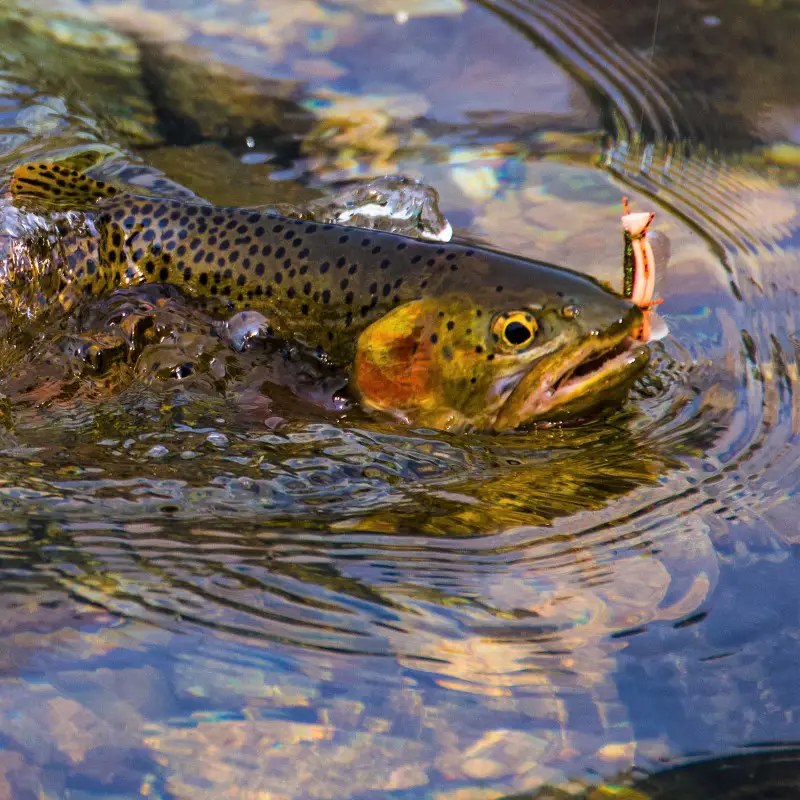Late summer, during the hopper the afternoon is one of my favorite times to fly fish. There is little that is more exciting than watching the swirls and splash as a trout rises from the depths to consume a hopper fly.
There are three main ways to fish a hopper. As a dry fly, targeting surface takes. As the ‘indicator’ in a hopper dropper rig, and finally sunken as a submerged fly. I prefer the first two, but all three are very effective techniques.
When is hopper season?
The first grasshoppers start hatching early in the spring from eggs that have been laying dormant over winter. Through spring they slowly increase in size and number with their population reaching a peak in early summer.
From a fishing perspective, the grasshopper season usually gets hot from mid-July all the way through to early September. It is common to see hoppers in significant numbers for several weeks before the trout start to show strong interest in them.
That is because it takes the trout several weeks to start to hone in on them as a major food source, but once that starts to happen the action is on.
There is certainly a strong correlation between the warmer months of summer and hopper activity. I have noticed, that trout will continue to take hopper well after the natural numbers have started to decline.
Best time of day to fish hoppers?
During the season I fish hoppers all day, rasises can be slow early in the morning but I simply enjoy fishing with large terrestrials too much so In my eagerness I will be fishing well before the trout are at their most eager.
Hopper fishing for trout is usually best from around 10 am into the early afternoon. This is because hoppers really only become active once the temperature starts to rise. The absolute best hopper fishing is in a cold water fishery during a hot and windy afternoon. In such conditions, both the trout and hoppers can be active at the same time of day.
By late afternoon warm water temperatures, in many fisheries can put a damper on hopper fishing. Sure there are plenty of natures around, but high water temperatures can make the trout reluctant to feed.
The hopper action usually starts to die down late in the afternoon, and by dinner it is usually time to get the dry flies out again.

Is it worth fishing hoppers if there are no naturals on the water?
I have caught a lot of trout when there are few or no naturals on the water. Sometimes I feel no stranded naturals is a good sign because it indicates that the naturals are getting eating quickly after hitting the water.
On the other hand, if I see a lot of naturals on the water, it might suggest the trout are not currently interested in feeding. When this occurs I take it as a sign that the water temperatures are a bit too warm for the trout to expend energy cruising the pools, so I concentrate my efforts where there is more oxygenated water.
I have also caught trout on hoppers in areas of a river far away from any grassy fields or hopper habitat. I assume enough hoppers get washed downstream so the trout can still recognize them.
What size hopper flies to fish?
I typically fish hopper sizing between #6 and #12.
Early in the season I fish slightly smaller sizes, but during the peak of the hopper season, I consistently catch trout on #6 or #8 hoppers. If you give a keen trout a good size meal they are more prepared to chase it down.
I generally do not match the size of my fly with the naturals. My hopper flies, are often smaller than the natural insects and the trout still eagerly take. Another reason I prefer smaller flies simply because I can cast them without changing to a much thicker leader. Smaller hopper flies can represent a broader selection of terrestrial insects.
What size tippet for hopper fishing?
During the hopper season, I am usually fishing a 2X or 3X tippet.
I suggest buying a dedicated 7.5ft a 1X leader to use for large terrestrial fishing and extending it out with a section of or 3X to make it around 9ft in length. I do not fish leaders longer than 9ft when hopper fishing, because I find it hard to turn over such heavy flies when using a 12ft leader.
A long leader, to eliminate drag is also of less importance when hopper fishing, because the naturals often struggle on the water, moving themselves against the current. The trout are used to unexpected movements.
I also have not noticed the trout being overly line shy when feeding on hoppers. I guess they are too interested in the juicy grasshopper to take much notice of what is happening around them.
Should I wiggle, or impart action into my hopper?
Nature hoppers often struggle around on the surface, so many fishermen wonder if it is beneficial to impart action into a hopper fly.
I have also thought the same over the years and have experimented quite a bit. In my opinion, imparted action does not attract more trout, and hopper flies work just fine when fish stationery. So I do not believe it is nessacary to impart action or slowly retrieve a hopper fly. Just let the current do its thing.
Bring several patterns
I have noticed that trout can become reluctant to take the same hopper pattern twice. If they have taken, but spat out a hopper pattern they will be very unlikely to take the same pattern again. Changing to a different pattern can easily fool the trout into a second attempt.
So for this reason, I always have several different patterns so I can change between them.
Hopper Patterns
There are dozens of hopper patterns, below are some of my favorite ones. During the summer terrestrial season, I always have several hopper and cicada patterns in my box. They can usually be fished interchangeably.
Walter Wiese’s GFA Hopper
A great general purpose foam body hopper pattern that is much simpler to tie than most hopper patterns. The foam body makes it highly buoyant, while the elk hair wing and foam hot spots make it highly visible. Because of its simplicity, and ease of tying this is one of my most fished hoppers.
Joes Hopper
Dating back to the 1940’s the Joe Hopper was one of the original hopper flies. Tied from entirely natural materials it remains a good option. Unlike more modern foam hoppers it is well suited to be fished drowned with some extra weight.
Daves Hopper
The Daves Hopper can be best summarized as a fusion between the classic Joe’s Hopper and the Muddler Minnow, with the latter addition of legs. What sets the Dave hopper apart is its highly lifelike appearance makes it a good option when the trout are stubborn. It is one of the most well known and fished hopper patterns around.
It is a very time-consuming and difficult pattern to tie, so I personalyl buy them.
Schroeder’s Parachute Hopper
Another versatile classic hopper pattern traditionally tied with only natural materials. It floats slightly lower in the water column than most hopper patterns while maintaining excellent buoyancy. It’s low floating position makes it less susceptible to wind drift. Thanks to the white parachute post it remains highly visible.
Rainy’s Grand Hopper
The Rainy’s grand hopper is a high floating hopper imitator which aims to be anatomically correct. It is a good representation of many grassland dwelling hoppers. Tied from buoyant 1/4 inch sheet foam the Rainy’s Grand Hopper is an excellent option for fishing more turbulent water.
Chernobyl ant
The Chernobyl ant is more a generalist terrestrial imitator than an exact replica of a grasshopper. Nevertheless, it has proven to be a very versatile and high performing fly when targeting summer terrestrials. I happily fish the Chernobyl ant as both a Cicada or Hopper imitator. The foam body means it floats extremely well.

